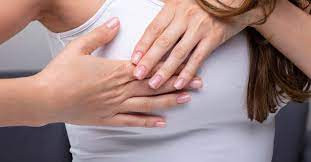Definition
Traumatic breast injury is a medical condition resulting from the breast getting injured, either caused by sharp or blunt force trauma. Sharp force trauma may entail being stabbed or scratched by an object with a sharp edge, while blunt force trauma can result from an impact or shock from a rigid object affecting the breast.
Regardless of the nature of the trauma, be it sharp or blunt force, various clinical symptoms and signs can manifest, notably pain or tenderness in the breast, referred to medically as mastalgia.
Traumatic breast injuries have the potential to cause damage and internal bleeding within the breast tissue, which may eventually lead to the development of a detectable lump. This bleeding can also result in the formation of a hematoma, marked by the collection of blood clots due to blood vessel rupture in the surrounding area of the breast.
Causes
Traumatic breast injuries commonly occur from various circumstances, such as:
- Accidental collision with a hard object impacting the breast
- Incidental contact or elbowing during physical exercise, particularly in certain sports competitions
- Engaging in activities without adequate breast support, such as not using a bra or a properly fitted supportive bra
- Incorrect use of a breast pump, deviating from manufacturer instructions
- Objects falling onto the breasts when in a supine position
- Frequent use of tight clothing
Risk factor
Awareness of various risk factors is crucial for both preventing and addressing traumatic breast injuries. While these injuries can impact anyone, certain factors can increase an individual's susceptibility to them.
Some risk factors include heavy or hard objects in one's vicinity, be it their surroundings or home, increasing the likelihood of accidental impacts. Breastfeeding mothers, particularly when utilizing breast pumps improperly, face a higher risk of traumatic breast injuries. Additionally, infrequent use of breast support (bras) during daily activities amplifies the risk of breast injury.
Symptoms
Several symptoms can arise due to traumatic breast injury, such as:
- Breast pain experienced at rest or tenderness. The pain can emerge immediately following the injury or may develop several days later.
- Observable bruising (breast contusion), characterized by bruises and swelling of the breast tissue. Swelling and bruising may indicate injury, with affected breasts potentially appearing larger than uninjured counterparts.
- Lumps or fat necrosis. Damage to breast tissue during injury can result in the formation of lumps or fat necrosis. These lumps are non-cancerous and frequently occur following trauma or surgery. Minimal redness or bruising may accompany these lumps, which may or may not be painful.
- Hematoma. A hematoma develops when blood vessels beneath the skin rupture due to traumatic breast injury. Hematomas typically resemble bruises on the skin and may appear within ten days following traumatic breast injury.
Diagnosis
Clinical diagnosis of traumatic breast injury primarily involves a medical history review and physical examination to identify bruising or lumps resulting from the injury. However, several diagnostic tests can provide additional insight if needed.
These diagnostic tests include mammograms, ultrasound, and MRI if needed. Mammograms are particularly useful for detecting hematomas, which appear as calcifications (white deposits) on the images. The lymphatic system will gradually reabsorb the hematoma and enter the bloodstream. These calcifications represent the body's response to the presence of a hematoma. Importantly, calcifications resulting from trauma discovered on a mammogram do not increase the risk of breast cancer.
Management
When dealing with traumatic breast injuries at home, several home remedies can help alleviate symptoms:
- Apply a cold compress to the injured area for 10-15 minutes during the first 2 days after the injury
- Use a warm compress if a hematoma (bluish bruise) appears
- Wear a comfortable, supportive bra to alleviate pain in the injured breast
- Pain relievers such as paracetamol or acetaminophen can be taken as needed
If symptoms persist or worsen despite home treatments, it's advisable to consult a doctor. They may prescribe stronger pain medication to relieve pain. If breast pain occurs after surgery or due to other health conditions affecting the breasts, you are not advised to take pain relievers.
Complications
Complications of traumatic breast injuries can include:
- Formation of a lump, which may indicate the presence of a hematoma
- Scar tissue of fat necrosis. Fat necrosis (death of fat tissues) can occur due to injury to the breast tissue. The scarring can occur in the breast tissue following surgical procedures (breast reduction surgery, fat grafting procedures, or lumpectomy (surgical removal of breast lumps). It manifests as hard lumps within the breast. Fat necrosis typically develops over several months to years after the initial trauma.
- Oily cysts. The formation of oily cysts is one of the complications of traumatic breast injury. It can result from tearing forces on the oily components of breast tissue. Oily cysts contain accumulated oily fluid within a cystic cavity, and the fluids could be released.
Prevention
There are several steps you can take to help minimize the risk of traumatic breast injury. Here are the steps to help prevent breast trauma:
- Exercise caution during sports and physical activities
- Wear appropriate breast support or a supportive bra during daily activities
- Choose comfortable clothing
- Avoid lying on your back if there are objects or heavy items above your body
When to see a doctor?
Looking for more information about other diseases? Click here!
- dr Nadia Opmalina
Sargent RE, Schellenberg M, Cheng V, Emigh B, Matsushima K, Inaba K. Breast Trauma: A Decade of Surgical Interventions And Outcomes From us Trauma Centers. Am Surg. 2022 Apr 27:31348221096580.
Healthline. Traumatic breast injuries. August 2018. https://www.healthline.com/health/breast-injury-trauma#treatment
Sanders C, Cipolla J, Stehly C, Hoey B. Blunt breast trauma: is there a standard of care? Am Surg. 2011 Aug;77(8):1066-9.
Lakeland Regional Health. Can injury to the breast cause cancer?. September 2019. https://www.mylrh.org/can-injury-to-the-breast-cause-cancer/








